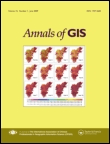
Annals of GIS
metrics 2024
Connecting Research and Real-World Applications
Introduction
Welcome to the Annals of GIS, a leading academic journal published by Taylor & Francis Ltd, dedicated to advancing the field of Geographic Information Science and its applications. With an ISSN of 1947-5683 and an E-ISSN of 1947-5691, this Open Access journal has been ensuring wide accessibility since 2019, thereby bolstering the dissemination of knowledge in areas such as remote sensing, spatial analysis, and geoinformatics. Hailing from the United Kingdom, the journal ranks impressively within its categories, achieving a Q2 status in Computer Science Applications and a prestigious Q1 ranking in Earth and Planetary Sciences for 2023, placing it in the top 10% among its peers. With a focus on innovative research spanning from 2009 to 2024, the Annals of GIS serves as a vital platform for researchers, professionals, and students alike, providing insights and fostering discussions that push the boundaries of geographic technologies and their real-world applications.
Metrics 2024
 0.92
0.92 2.70
2.70 3.90
3.90 40
40Metrics History
Rank 2024
Scopus
IF (Web Of Science)
JCI (Web Of Science)
Quartile History
Similar Journals
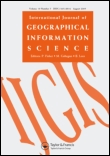
INTERNATIONAL JOURNAL OF GEOGRAPHICAL INFORMATION SCIENCE
Leading the Way in Geographical Research ExcellenceThe INTERNATIONAL JOURNAL OF GEOGRAPHICAL INFORMATION SCIENCE, published by TAYLOR & FRANCIS LTD, stands as a premier platform in the fields of geography, planning and development, and information systems. With an impressive impact factor and recognized as a Q1 journal in 2023 across multiple categories, this esteemed publication underscores its significant role in advancing knowledge and application in geographical information sciences. Since its inception in 1997, the journal has provided vital insights and research findings, appealing to a diverse audience of researchers, professionals, and students dedicated to exploring the complexities of spatial data and its implications. Notably, it boasts exceptional Scopus rankings, positioning it among the top journals in its fields. While the journal does not offer open access, it remains a crucial resource for those looking to deepen their understanding and engagement with contemporary geographic and information science issues.
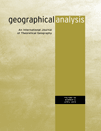
GEOGRAPHICAL ANALYSIS
Transforming Understanding of Environmental ImpactsGEOGRAPHICAL ANALYSIS, published by WILEY, is a premier scholarly journal that has been at the forefront of geographical and earth-surface research since its inception in 1969. With an ISSN of 0016-7363 and an E-ISSN of 1538-4632, this journal has established itself as an essential resource for researchers and professionals in the fields of Earth-Surface Processes and Geography, Planning and Development, achieving impressive rankings of 13th and 60th in their respective categories according to Scopus, placing it in the Q1 quartile for both. The journal is renowned for its rigorous peer-reviewed articles that contribute valuable insights into spatial analysis, environmental impacts, and urban planning, thus fostering a deeper understanding of geographical phenomena. With access options available through traditional subscriptions, GEOGRAPHICAL ANALYSIS continues to serve as a critical platform for the dissemination of cutting-edge research and innovative methodologies, ultimately shaping the future of geographical inquiry and application.

Journal of Geovisualization and Spatial Analysis
Navigating the Future of Earth Sciences with PrecisionJournal of Geovisualization and Spatial Analysis, published by SpringerNature, is an influential open-access journal specializing in the cutting-edge fields of geovisualization, spatial analysis, and their application in earth sciences and geography. Since its inception in 2017, this journal has established a prominent stance with a high impact factor and prestigious Q1 rankings across multiple categories, including Computers in Earth Sciences, Earth and Planetary Sciences (miscellaneous), and Geography, Planning and Development. The editorial board is committed to advancing innovative research and methodologies, providing a platform for scholars to disseminate their findings globally. With impressive Scopus rankings—placing it in the top percentiles among its peers—the journal serves as a vital resource for researchers, professionals, and students keen on understanding spatial data and its implications for geographic science. Its emphasis on rigorous peer review and rapid publication enhances accessibility to substantive research, thus fostering knowledge sharing within the scientific community. Based in Switzerland, the journal promotes a collaborative environment for interdisciplinary studies, making it an essential read for anyone involved in spatial analysis research.

Geo-Spatial Information Science
Innovating Insights in Spatial Data AnalysisGeo-Spatial Information Science, published by TAYLOR & FRANCIS LTD, is a premier open-access journal that has been at the forefront of disseminating cutting-edge research since its inception in 1998. With an ISSN of 1009-5020 and an E-ISSN of 1993-5153, this journal plays a pivotal role in the fields of Computers in Earth Sciences and Geography, Planning and Development, achieving a prestigious Q1 ranking in both categories as of 2023. Its exemplary Scopus rankings highlight its relevance within the social sciences and earth sciences, placing it among the top echelons of its field, with a 95th and 93rd percentile respectively. The journal aims to bridge the gap between innovative geospatial technologies and their applications in real-world scenarios, fostering interdisciplinary collaboration and advancing the global understanding of spatial data analysis. Based in the United Kingdom, Geo-Spatial Information Science invites researchers, professionals, and students to contribute and access research that shapes the future of geo-spatial sciences, all while adhering to open access principles that ensure broad dissemination and engagement with the broader academic community.
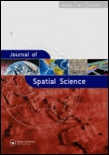
Journal of Spatial Science
Advancing Interdisciplinary Insights in Spatial ScienceThe Journal of Spatial Science, published by Taylor & Francis Ltd, serves as a prominent platform for the dissemination of research in the interdisciplinary fields of geography, atmospheric science, and energy. With an ISSN of 1449-8596 and an E-ISSN of 1836-5655, this journal has established itself as a vital resource since its inception in 2004, boasting an impressive convergence period extending to 2024. Recognized in the Q3 quartile for Atmospheric Science and Energy (miscellaneous), and achieving a Q2 classification in Geography, Planning and Development in 2023, the journal not only reflects the evolving complexities of spatial science but also underscores its increasing relevance in addressing contemporary global challenges. The journal holds a commendable position in Scopus rankings, with notable placements in various categories, further highlighting its academic significance. Researchers, professionals, and students are encouraged to engage with the rich content offered, as the Journal of Spatial Science remains committed to advancing knowledge and fostering discussions pertinent to spatial analysis and its applications.

Revue Internationale de Geomatique
Elevating Standards in Geomatics MethodologiesRevue Internationale de Geomatique (ISSN: 1260-5875, E-ISSN: 2116-7060) is a prestigious journal published by TECH SCIENCE PRESS, dedicated to advancing the field of geomatics. This journal serves as a vital platform for disseminating significant research findings, cutting-edge methodologies, and innovative applications within the realm of spatial data and technology. With an emphasis on interdisciplinary studies, it fosters collaboration among researchers, professionals, and students across various domains, including environmental science, urban planning, and geographic information systems (GIS). Although not an open-access journal, Revue Internationale de Geomatique maintains a rigorous peer-review process ensuring the publication of high-quality articles that contribute to the evolving landscape of geomatics. Given its relevance and commitment to scholarly excellence, this journal is a crucial resource for advancing knowledge and practices in the ever-growing field of spatial information science.
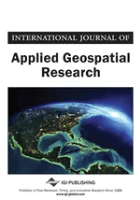
International Journal of Applied Geospatial Research
Empowering multidisciplinary contributions in geospatial research.International Journal of Applied Geospatial Research is an esteemed publication dedicated to advancing the field of geospatial research. Published by IGI Global, this journal provides a platform for innovative studies from 2010 to 2024 that encourage multidisciplinary contributions across Earth and planetary sciences and geography. While currently not offering open access, the journal's focus on applied research ensures that it remains highly relevant to both academics and industry professionals alike. With an ISSN of 1947-9654 and an E-ISSN of 1947-9662, it has been indexed in various databases, reflecting its emerging significance with rankings such as Q4 in Earth and Planetary Sciences and Geography according to Scopus, placing it at the intersection of critical research and practical application. Researchers, professionals, and students can expect insightful articles that enhance understanding and drive innovation in geospatial applications essential for informed decision-making in a rapidly changing world.

GEOINFORMATICA
Leading the Way in High-Impact Geoinformatics ResearchGEOINFORMATICA is a leading journal in the field of geoinformatics, widely recognized for its contributions to both Geography, Planning and Development as well as Information Systems. Published by Springer, this journal holds a distinguished Q1 ranking in Geography and a Q2 ranking in Information Systems as of 2023, reflecting its high-impact research contributions and authoritative voice in these disciplines. Since its inception in 1997, GEOINFORMATICA has provided a platform for innovative research, methodologies, and applications related to geographic information science, spatial data analysis, and remote sensing technologies. The journal's rigorous peer-review process and strategic positioning within the academic landscape allow it to attract a diverse array of publications, assisting researchers, professionals, and students in understanding complex spatial phenomena. While the journal does not offer Open Access, it remains a vital resource located in the Netherlands, and its indexed status has secured impressive Scopus rankings—#131 in Geography, Planning and Development, and #134 in Information Systems, showcasing its robust scholarly influence. Explore the latest developments and cutting-edge research through GEOINFORMATICA, where scholarly excellence converges with real-world relevance.

Applied Geomatics
Exploring the intersection of technology and environmental science.Applied Geomatics is an esteemed academic journal published by SPRINGER HEIDELBERG, dedicated to advancing the field of geomatics through rigorous research and innovative applications. With an ISSN of 1866-9298 and an E-ISSN of 1866-928X, this journal has gained a prominent standing in multiple disciplines, achieving a Q2 ranking in esteemed categories such as Earth and Planetary Sciences, Engineering, Environmental Science, and Geography. The journal's convergence of research from 2009 to 2024 positions it as a vital resource for both scholars and practitioners seeking to understand and leverage geomatic technologies in real-world scenarios. Located in Germany, Applied Geomatics not only contributes to theoretical advancements but also to practical methodologies that address current environmental challenges. Its accessibility and relevance ensure that the findings discussed within its pages are pivotal for professionals, researchers, and students alike, fostering collaboration and innovation within the field.
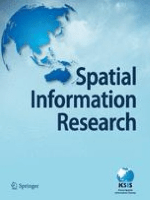
Spatial Information Research
Illuminating the path for future spatial applications.Spatial Information Research, published by SPRINGER SINGAPORE PTE LTD, is a prominent journal committed to advancing the interdisciplinary field of spatial information science. With an ISSN of 2366-3286 and an E-ISSN of 2366-3294, this journal serves as a crucial platform for disseminating research findings from 2016 to 2024, focusing on applications in Artificial Intelligence, Computer Science Applications, and Geography, among others. Ranking in the Q2 and Q3 quartiles across various categories, it showcases impactful research that informs geographic planning, environmental sciences, and computational methodologies. The journal's rigorous peer-review process ensures high-quality contributions that offer insights for both academic scholars and industry professionals. While retaining exclusive access options, Spatial Information Research is a vital resource for researchers eager to explore the complexities of spatial data and its applications in real-world scenarios.